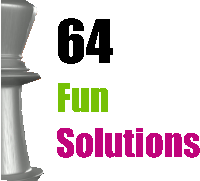Level
3-Bishop
Chess Diagram
[Event "Puzzle #34"][Date "2008.08.28"][Result "1-0"][SetUp "1"][FEN "4k3/4P3/4q3/4Q3/4q3/4Q3/4p3/4K3 w - - 0 1"]
Next week we are going to re-open the club and with the exception of the top students from last year, everyone else will have to pass the admission test. The best way to practice for it is to review our lessons (if you attended last year), go over the intermediate puzzles from "Puzzle of the week" here on the website, as well as take up the challenge to solve the following nice and apparently easy puzzle (see diagram).
White to move and mate in 4.
The author for this puzzle is Phillip L. Michael from Arizona, USA. Total available points for this puzzle is 5. The answers will be published next week together with puzzle #35. Do not forget that anyone can answer!
Puzzle #33 solution:
Sometimes you need to be lucky to get the result you desire. However never forget that only the good players are lucky! This is something I have experienced time and time again, having no doubt in my mind it is true :-) Responses:
a) Good analysis with a few slips from most of you. Will mention just the most important points to consider:
- White has a passed supported pawn on the 7th rank; please remember at all times how much it is worth!
- "Rc1" has a much higher qualitative value than "Ra7" for reasons like: it is on an open file and behind a passed pawn;
- Black has a passed supported pawn, but "d3" has reached only the 6th rank so far;
- Black also has a pair of Bishops he must use, or the game will end fast; these Bishops must work together with the pawn chain "d3-h6" to create threats agains "Kg1"
b) Most of you have agreed that 32... Ra7? is a mistake because of the awkward position and the fact in leaves 'Bc8" unprotected. "c8" is the most dangerous spot and it should have been kept under control. The correct move is indicated by the authors in a very nice and extensive piece of annotation: 32... Bd4! has a dual purpose: protects "b6" and attack "f2" which might be in danger if the "d3-h6" pawn chain begins to advance.
c) The most interesting response I received was from Joshua; please see it below together with the other considerations:
[Event "Puzzle #33"][Date "2008.08.23"][Result "0-1"][SetUp "1"][FEN "r1b5/2P3k1/5b1p/pB3pp1/P1N1p3/3p3P/1P3PP1/2R3K1 b - - 0 32"]32...Ra7? (32...Bd4! {Serves a dual purpose: protects "b6" and attack "f2" which might be in danger if the "d3-h6" pawn chain begins to advance}) 33.Nb6? {In the game} (33.Nd6 Be5 {A good sequence of strong moves could have been (shown by the book authors)} (33...Bxb2 {Joshua's response} 34.Nxc8 d2 35.Rd1 Rxc7 36.Rxd2 Bc3 37.Rd7+ Rxd7 38.Bxd7 {White is winning}) 34.Nxc8 d2 35.Rd1 Rxc7 36.Nb6 Rc1 37.Be2 Bxb2 38.Nc4 Bc3 39.Nd6 Kf6 40.g4 {White has very good winning chances after it blows away Black's pawn chain}) 33...d2 34.Rd1 Rxc7 35.Rxd2 Be6 {From this completely reversed situation Black won in 5 moves}
Correct solutions:
Jeremy - 10 points
Joshua, John - 6 points
Wilson, Nathaniel - 4 points
Standings:
63.0 John
58.0 Joshua
50.0 Jeremy
47.0 Wilson
17.0 Nathaniel
15.0 Karl
10.0 Jacob
White to move and mate in 4.
The author for this puzzle is Phillip L. Michael from Arizona, USA. Total available points for this puzzle is 5. The answers will be published next week together with puzzle #35. Do not forget that anyone can answer!
Puzzle #33 solution:
Sometimes you need to be lucky to get the result you desire. However never forget that only the good players are lucky! This is something I have experienced time and time again, having no doubt in my mind it is true :-) Responses:
a) Good analysis with a few slips from most of you. Will mention just the most important points to consider:
- White has a passed supported pawn on the 7th rank; please remember at all times how much it is worth!
- "Rc1" has a much higher qualitative value than "Ra7" for reasons like: it is on an open file and behind a passed pawn;
- Black has a passed supported pawn, but "d3" has reached only the 6th rank so far;
- Black also has a pair of Bishops he must use, or the game will end fast; these Bishops must work together with the pawn chain "d3-h6" to create threats agains "Kg1"
b) Most of you have agreed that 32... Ra7? is a mistake because of the awkward position and the fact in leaves 'Bc8" unprotected. "c8" is the most dangerous spot and it should have been kept under control. The correct move is indicated by the authors in a very nice and extensive piece of annotation: 32... Bd4! has a dual purpose: protects "b6" and attack "f2" which might be in danger if the "d3-h6" pawn chain begins to advance.
c) The most interesting response I received was from Joshua; please see it below together with the other considerations:
[Event "Puzzle #33"][Date "2008.08.23"][Result "0-1"][SetUp "1"][FEN "r1b5/2P3k1/5b1p/pB3pp1/P1N1p3/3p3P/1P3PP1/2R3K1 b - - 0 32"]32...Ra7? (32...Bd4! {Serves a dual purpose: protects "b6" and attack "f2" which might be in danger if the "d3-h6" pawn chain begins to advance}) 33.Nb6? {In the game} (33.Nd6 Be5 {A good sequence of strong moves could have been (shown by the book authors)} (33...Bxb2 {Joshua's response} 34.Nxc8 d2 35.Rd1 Rxc7 36.Rxd2 Bc3 37.Rd7+ Rxd7 38.Bxd7 {White is winning}) 34.Nxc8 d2 35.Rd1 Rxc7 36.Nb6 Rc1 37.Be2 Bxb2 38.Nc4 Bc3 39.Nd6 Kf6 40.g4 {White has very good winning chances after it blows away Black's pawn chain}) 33...d2 34.Rd1 Rxc7 35.Rxd2 Be6 {From this completely reversed situation Black won in 5 moves}
Correct solutions:
Jeremy - 10 points
Joshua, John - 6 points
Wilson, Nathaniel - 4 points
Standings:
63.0 John
58.0 Joshua
50.0 Jeremy
47.0 Wilson
17.0 Nathaniel
15.0 Karl
10.0 Jacob

Mate in 4